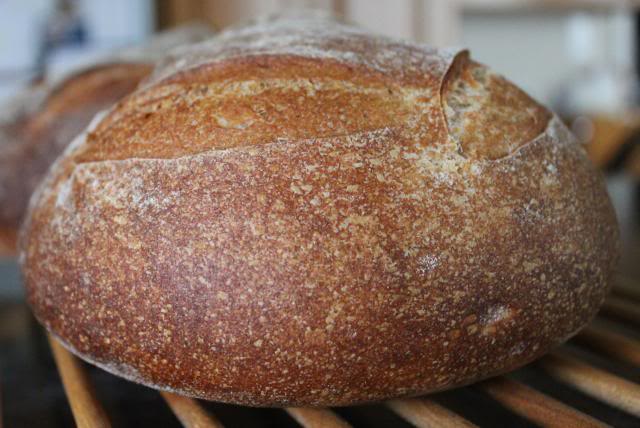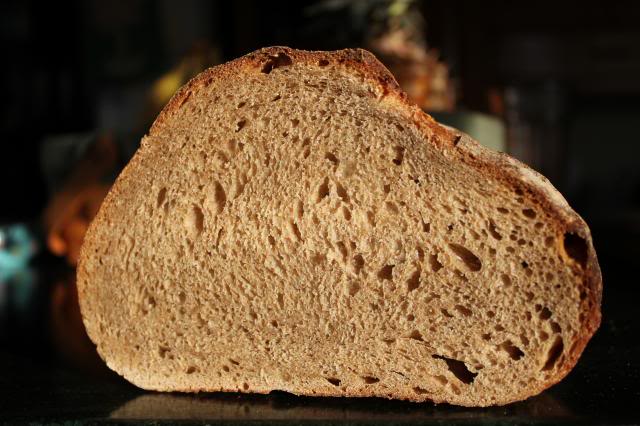
Hamelman's Whole Wheat Levain
Since I had Friday off last weekend, and since the weather on Friday and Saturday was rainy, it seemed like a golden opportunity for baking some bread. While perusing Hamelman's Bread, the Whole Wheat Levain was the one that I kept coming back to as I weighed the alternatives.
The first step was to build the levain. Since my kitchen temperature was several degrees cooler than Hamelman's reference temperature, I elected to increase the inoculation by about 20%. I also allowed the levain a longer time to develop, by perhaps 4 hours or so. What greeted me on Saturday morning was a fully domed levain that was showing just the earliest hints of an impending collapse.
The next step was to build the dough. The formula directions are based on machine mixing; I did all mixing and kneading by hand. It appears that the whole wheat flour that I used (Great River Milling) may have a higher protein content than Chef Hamelman's. Now that I say that, it seems somewhat improbable, given that his formula is probably based on King Arthur flours. Regardless, for the same hydration, my dough seemed a bit firmer than his description. While soft, it was never "loose" and no bench flour was required during kneading.
The dough was then set to bulk ferment at room temperature, with stretch and folds at the recommended intervals. After the bulk ferment, I shaped the loaves into boules and put them in floured bannetons for the final fermentation, with plastic wrap shielding the exposed surfaces, also at room temperature. When the loaves were perhaps 75% expanded, my wife suggested we run some errands, so I put the bannetons into the refrigerator to hold until we returned home. That turned out to be 3 or 4 hours later, so it is very good that I didn't leave the loaves at room temperature in anticipation of an earlier return!
Upon returning, I set the loaves out on the counter to finish their final ferment. When they appeared to be doubled, but before they felt wobbly, I preheated the oven and stone. When all was up to temperature, the oven was steamed, the loaves were tipped from the bannetons and scored, then into the oven they went. The dough was still cool enough that the steam immediately condensed on the loaves' surface, leaving them glistening for the first minute or two. A peek throught the window a few minutes later revealed a healthy oven spring in progress.
I checked for doneness at the end of the recommended bake time and pulled the loaves from the oven. This is how they looked:

Although not readily visible in this shot, there was a small amount of tearing at one slash on each loaf, suggesting that I could have allowed even further fermentation.
The crumb, while acceptable, seconds the notion that additional fermentation would have been optimal. The bulge at the one slash is more evident:

That, or I should have kneaded less, allowing a more open crumb. Or some of each.
The other thing that could have been done was to allow the loaves to stay in the oven a few minutes more. While fully baked, more baking would have deepened the color (and flavor!) and dried the crumb somewhat.
But these are small matters, the difference between a good bread and a really good bread. The crumb is moist, but not soggy; firm, but with a pleasing softness; and eminently suited for its primary role as sandwich material. No spilled mustard from those holes! The flavor is primarily wheat, with distant notes of hazelnut and caramel. There's only the smallest hint of a sourdough tang; quite suprising, considering the extended fermentation of both levain and dough. The fragrance tells you immediately that this is the real deal, not a tricked up wannabe.
By contrast, when my wife and I were at the supermarket (one of the errands), we happened to walk down the bread aisle and it smelled disgusting. That's never really struck me before, even though I've baked most of our bread for 30-mumble years. I'm not sure which thing(s) in that "bread" I was smelling but it almost turned my stomach. And no, it had nothing to do with a lack of cleanliness in the store; this was coming entirely from the product. Yuck!
So, color me happy with my bread and thanks to Chef Hamelman for this specific bread.
Paul


Comments
the old chicken parts at Hen House left over from 40 years ago when i delivered pop there. Hidden chicken parts used to make the whole store smell but I know they have cleaned up their act and are actually up scale now and have expanded to se3veral stores. Very nice WW bread Paul. You haven't lost your touch in those 30+ years making bread at home. Your example of hmelman's staple is first rate.
Happy Baking,.
And decaying chicken wasn't one of the flavor notes, either. You are right about the Hen House stores aiming for the upper end of the market. Of course, that's all I've ever seen of them since I only got here 20 years ago or so.
Thanks for your compliments
Paul
Lovely bake, Paul! quite an accurate description of the bread, one that i love to bake every once and a while.
Could it be the smell of the plastic packaging of the bread?
-Khalid
It is a delightful bread to have, isn't it?
The plastic packaging didn't seem to factor into the odor. My guess is that it is one or several of the items that aren't in the flour/water/salt/yeast list.
Paul
Hi Paul,
This is a lovely bread. I usually get a similar crumb as well. You reminded me to return to it.
The supermarket smell - I know what you mean. Same here in the UK, some places are worse than others.
I thought it might be the overuse of malt in wheat breads (my personal unconfirmed thought), maybe Andy can shed some light?
Juergen
It's good to hear that my results weren't a weird outlier.
I'm not able to say about the malt, although it wouldn't be my first guess. More likely the things that require 3 or 4 syllables or odd combinations of letters and numerals for their names, methinks.
Paul
Looks like a great loaf to eat as your regular everyday bread Paul
Regarding protein content, you should remember that the headline reading is merely an indicator. I suspect the King Arthur flour contains more of the higher quality protein required for gluten formation, even though the headline figure might be lower than the flour you used. However, I speak from the other side of the pond, but I do know of the King Arthur reputation, and that doubtless Mr Hamelman has a very large say in the prescribed specifications of the company's flour range.
The bread aisle at supermarkets is one I usually avoid, although the smells I get tend to be those coming from the dreadful over-sweetened rubbish that some would have us believe passes for confectionery, nay, even patisserie!? Excess yeast and the "flavourings" which now tend to be added to the notorious colour-coded ingredients sachets are probably the most likely sources for foul-smelling bread. Apparently there is a greater "artisan-focus" from UK supermarket bakeries! Please spare us from such misery!
Very best wishes
Andy
Except, of course, that so many others are, too. :-)
It would probably take a side by side bake of the same bread with the different flours to have a notion of how they behave. Having looked it up now, I see that both KA and Great MIlls list their whole wheat flours at 14% protein. Whatever the underlying differences may be, I observed a firmer dough than I expected from Hamelman's description.
Most of the product on display that day was either sandwich loaves or buns and rolls, all bagged in plastic. I don't recall seeing any of the sweet stuff, although I agree with you about those flavors. Although all of it would have been delivered that morning, there was nothing that smelled fresh or grainy or wholesome. Part of the odor may have come from excessive yeast, I suppose. It smelled as though it should have been bread in the same way that a plastic or silk flower looks as though it should be a real flower. Which is to say, it smelled like something false, something devoid of the reality it was supposed to mimic. The effect was completely off-putting.
Paul
Nice looking loaves Paul. I will have to add this one to my list to try.
I'm with you on the smell...it's probably from the high fructose corn syrup and other hidden goodies in the processed bread.
This is a good one, so if you can find space on your list, do add it.
The odor in the bread aisle was quite another thing. Phew!
Paul